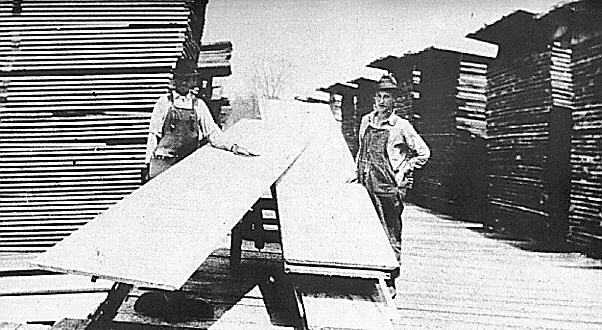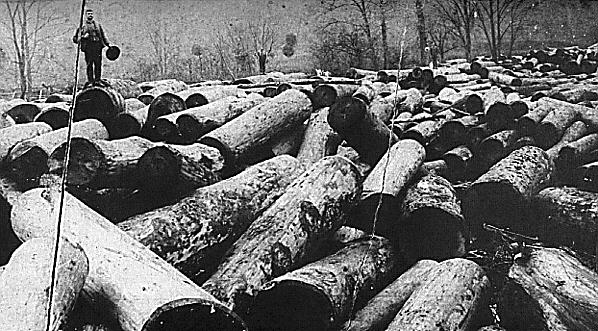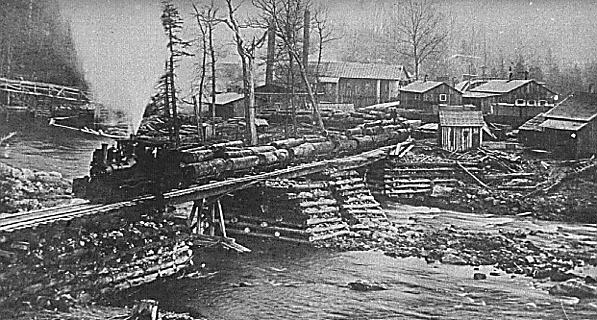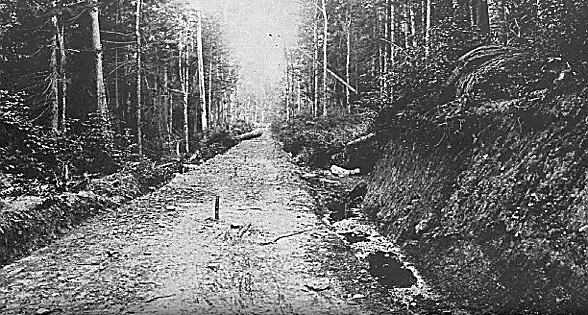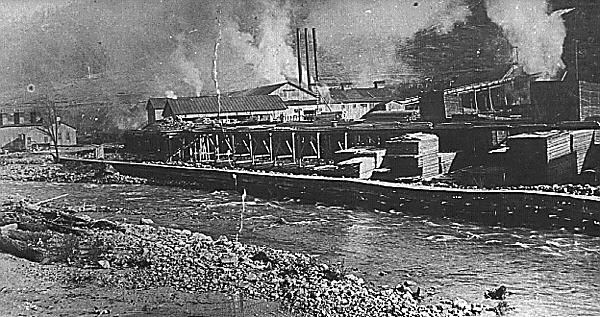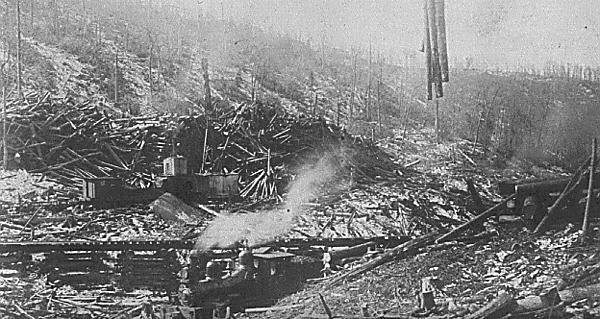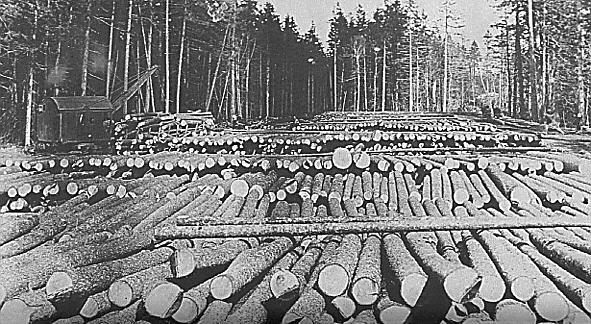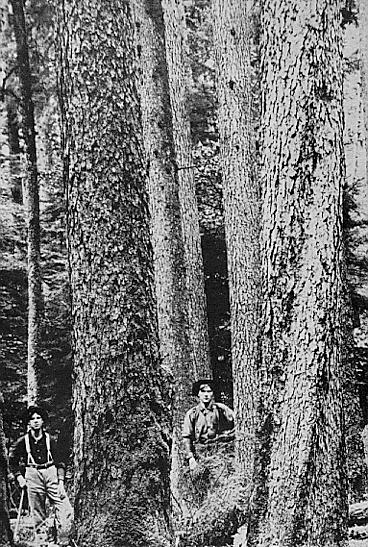Logging the Virgin Forests of West Virginia
Man Discovers the Alleghenies
Originally, pioneers wandered into the West Virginia mountains during the mid-1700’s through early 1800’s. The first town settled west of the Alleghenies was Marlinton, and many of the old houses built during that time are still standing in town. Many of the largest trees in the forest occurred along river courses and valley bottomland used for farming. These were the first acreages to be cleared. We’ll probably never know how large the BIGGEST trees were in West Virginia since the cuttings were not documented.
Man was quick to recognize the economic potential of the extensive woodlands in this “new” territory. Originally, early logging efforts were undertaken with simple cross-cut saws. One man would stand on the top of a felled log and the other worked in a pit dug into the ground. However, this was an inefficient, labor intensive method of sawing timber. Manual cutting was soon replaced by water-powered cutting mills. With the evolution of the steam engine, and the circular saw invented by an Englishman named Miller in 1777, “production” mills started to appear across the state. In 1835, there were fifteen circular sawmills powered by steam in the area now comprising West Virginia. By 1880, there were 472 lumbering establishments, the majority of which were circular steam mills. By 1882, there were 82 sawmills along the Chesapeake and Ohio Railroad alone. Despite the rapid growth of these mills throughout the state, logging in West Virginia didn’t really take off until the introduction of two new inventions – the Band Saw and the Shay locomotive.
The Beginning of the End
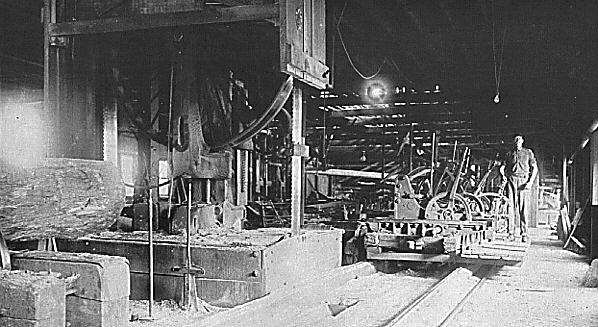
During the forty-year heyday of large-scale logging production in West Virginia, the band saw mill was king. It required 17 acres per day of West Virginia virgin timber to keep the gaping portal of a single mill filled with a steady flow of logs. In 1909, at the peak of lumber operations, there were 83 band mills and 1,441 other lumbering establishments operating in the state. Nearly one and a half BILLION board-feet of lumber were produced during that year.
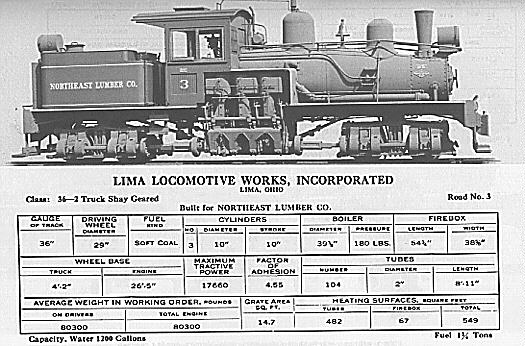
It was clearly necessary that a special locomotive be developed for logging service. This engine was not to be evolved at the drafting board of a locomotive builder, but in the field. An ingenious lumberman, Ephraim Shay, is generally credited with the idea and construction of the first geared locomotive. By using reducing gears instead of side rods, his locomotive achieved unheard-of freedom of movement on rough, hilly, and sharply curved track, and a more smoothly applied, higher tractive effort with minimum locomotive weight. High stability with low speed was required, and achieved by the Shay locomotive.
The success of the geared engine for mountain logging was phenomenal. Lima Locomotive Works and its successors of Lima, Ohio (which produced the Shay between the years 1880 and 1945) made 2,761 Shays. Of this number, over 200 were used in West Virginia logging. The geared design opened a new era in logging. For the first time it was possible to operate a locomotive on track that was no better than that formerly required by animal-powered tramways.
The Virgin Forest Falls
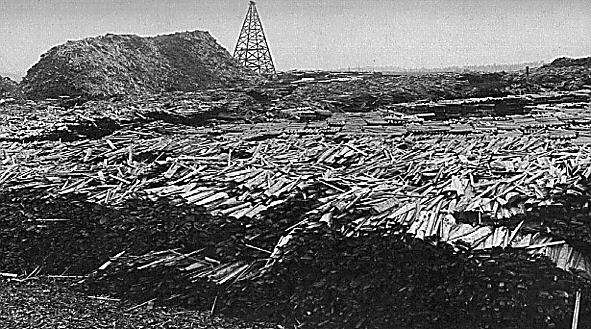
With the introduction of the band saw and Shay locomotive, rail-lines started snaking into the deepest hollows of the West Virginia mountains. The virgin forests of the Alleghenies rapidly fell to the lumberman’s cross-cut saw. The decline of the forest is shown very dramatically by comparing the following statements:
1835 – “West of the Alleghanies a large portion of the country must forever remain in its primitive forest.” (Joseph Martin)
1870 – “At least 10,000,000 acres are still in all the vigor and freshness of original growth.” (J.H. Diss Debar)
1876 – “Between 9,000,000 and 10,000,000 acres are in the original forest.” (Maury and Fontaine)
1893 – “Nearly or quite one-half of the State is still uncleared, and by far the greater portion of the uncleared land is still in virgin forest.” (George W. Summers)
1900 – “The wooded area of West Virginia is estimated at 18,400 square miles, or 73 per cent of the area of the State and most of this is occupied by timber of mercantable size and quantity.” (Henry Gannett)
1910 – The virgin forest area in 1910 is slightly over 1.5 million acres.
1920 – The original forest is completely depleted, except for a few isolated areas of small acerage.
It has been estimated that from 1879 to 1912, the total cut of lumber in West Virginia was more than 20 billion board feet. By far, the greater percentage of this was cut by band mills. This figure represents the lumber from 8,500,000 acres of virgin forest or more than 85 per cent of the total timbered area of the State. The total lumber cut in West Virginia between 1870 and 1920 was more than 30 billion board feet. This amount of lumber would build a boardwalk 127 feet wide and 2 inches thick around the circumference of the earth, or would make a walkway 13 feet wide and 2 inches thick the average distance to the moon.
The following pictures tell the story:
